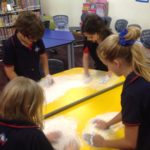Lesson Overview:
In this lesson, students review the water cycle, learn about a famous painter, and clean their desks all at the same time! Three integrated elements, one class period, and a heck of a good time!
Lesson Plan:
Suggested Grades:
3-4
Objective:
To review the water cycle through literature and to show understanding of the stages of the water cycle by “painting” it.
Suggested Time:
40-45 minutes
Success Criteria:
Each child will successfully demonstrate the stages of the water cycle by “painting” it using shaving cream on a desktop. (Each child will also clean his/her desk in the process.)
Lesson Outline:
1. Introduction:
Ask the children what the water cycle is. Ask them to name steps in the water cycle. Be sure to get the idea that the cycle is circular and repetitive.
Explain that the water cycle has inspired many authors and illustrators to make stories. There are stories about rain, about storms, and about the journey of a single raindrop from the clouds to the sea and back again.
Inform the students that today we will examine the work of one amazingly talented artist, Thomas Locker, and his portrayal of the water cycle. Ask the children to pay attention to Mr. Locker’s presentation of various phases of the water cycle. They should think about the number of steps in Mr. Locker’s “Water Dance” so that they can compare it to the more scientific water cycle.
Tell the kids that if they do their work well and follow the instructions carefully, they will get to paint the water cycle by using clouds!
Do not tell the kids in advance that they will be using shaving cream. Once you announce that, they will not be able to focus on anything else. Keep the shaving cream a surprise until the end.
2. Main:
Pass out the student handout and go over the instructions together.
Share Water Dance with the class. Read the poetry and try to have the kids guess which part of water Mr. Locker is describing before showing them the paintings. Also before showing the kids the artist’s work, ask the kids to imagine what it might look like if they had to paint this scene.
The stages in Mr. Locker’s water landscapes may vary slightly from that which the kids have learned. That’s okay – they should be able to mentally bridge and understand any differences.
Once the book has concluded, review the water dance with the children. Ask them how it is the same or different from the water cycle. Once you are certain that they have a firm understanding of the water dance vs. the water cycle, ask them why Mr. Locker put extra steps in his book. Why did he go to the effort of painting all those pictures when he could have used a camera? What was he trying to show with his paintings? (Answer: Beauty. Mr. Locker is trying to convey the beauty of water’s journey through earth, not just it’s scientific steps!)
Next, tell the kids that you will give them a cloud. They will use the cloud to “paint” the water cycle on their desktops. Each child receives one handful of cloud (ie. shaving cream) and must be careful to use it well. Once a step is painted, it can be smoothed over and the next step in the water dance painted. Or groups can work together to “paint” a set of scenes on several desks. There is room for a lot of creativity in this lesson.
3. Conclusion:
Thanks for thinking about the work of Thomas Locker, the water cycle, and for creating the entire water cycle right here in class! Tidy up with buckets and cloths – the desks will be sparkling clean!
additional Resources:
- Any book of your choice that highlights the water cycle. My favorite is Water Dance by Thomas Locker.
- Two cans of shaving cream.
- Desktops, cleared of papers, books, and pencils.
- Buckets with clean water for rinsing hands
- A few washcloths to wipe the desks down afterwards
- Camera to take a few photos of the students in action.
- Student Handout.
Notes:
Students should have been taught and understand the concept of the water cycle prior to this lesson.
This lesson is also a great one to do as a “one off” on a rainy day or on a day when the classroom needs to be cleaned.
It may be helpful if the water cycle is displayed somewhere in class.
Desks must be clear of most books, papers, and materials before this lesson starts.
One year, two minutes into his shaving cream, a little boy looked at me and shouted, “Hey, you TRICKED US! We’re CLEANING.” Be ready. The kids are smart and will figure this out. My response was something along the lines of, “Two birds, one stone.”
You must be VERY strict with the kids about not putting shaving cream on each other and not messing around. Usually it works, but the last minute or two are always exciting!!
Be sure to snap a few photos. The kids love the tactile aspect of this lesson and really, really have fun with it.
Key Terms:
Water, Water Cycle, Storms, Rain, Thomas Locker, Painters
recommended texts:
Water Dance by Thomas Locker.
example:


